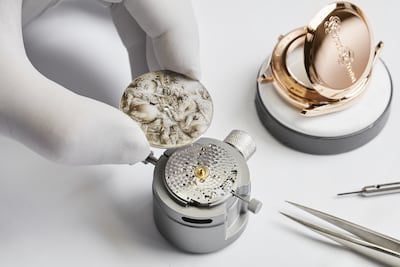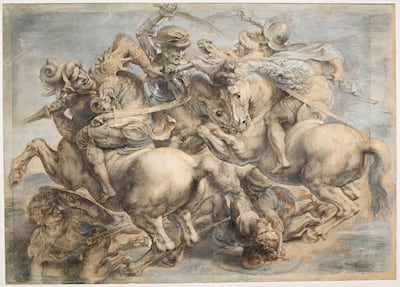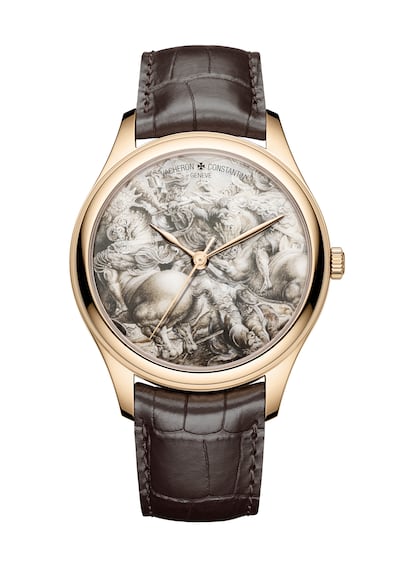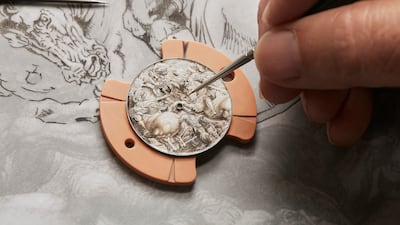Watchmaking and art have a timeless bond, so it is little wonder that Vacheron Constantin – the Swiss luxury watch and clock manufacturer founded in 1755 – has chosen the Louvre Museum in Paris as its aesthetic partner since 2019. The two institutions, which were established in the same century, have forged a cultural and artistic collaboration over the past four years, which continues to thrive today.
Vacheron Constantin already has an extraordinary range of artistic resources at its disposal, including in-house guilloche experts, jewellery setters and master enamellers and engravers. Last year, it leveraged its top talent to collaborate with the museum on a collection of four Metiers d’Art, or master of art, watches. Each is inspired by one of the museum’s many great works of art celebrating ancient civilisations.
One dial is engraved with a sphinx adorned with the nemes headdress worn by the rulers of the ancient Egyptian empire. Another pays homage to the ancient empire of the Achaemenids, engraved with the Frieze of Lions, a glazed brick decoration located in the first courtyard of the Palace of Darius in Susa, Iran.
The third features the statue of Victory, a winged goddess resting on the prow of a warship as a tribute to the Hellenistic Greece of the Antigonid dynasty. The fourth and final watch is engraved with the bust of Octavian Augustus, the adopted son of Caesar, wearing an oak wreath, representing the Julio-Claudian dynasty of the Roman Empire.
These four limited-edition watches have already been sold. However, while they may or may not return to the auction block, watch collectors and art connoisseurs can still commission Vacheron Constantin to reproduce miniature versions of thousands of the Louvre’s artworks (the Mona Lisa remains out of bounds, though), as part of its ongoing A Masterpiece on the Wrist programme. Titled Les Cabinotiers watch collection, such timepieces are guaranteed to be the only one of their kind.
A letter of authenticity from the museum will certify the reproduction. Louis Ferla, chief executive of Vacheron Constantin, says: “With the Louvre Museum, we are writing an extremely promising joint history by combining our fields of competence and our wildest dreams.”
As part of the initiative, one private buyer commissioned The Fight for the Standard detail from the Battle of Anghiari artwork to be recreated as a timepiece.
The drawing, planned by Leonardo da Vinci in 1505 and executed by Flemish artist Peter Paul Rubens in 1603, is usually only viewable by making an appointment with the Department of Graphic Arts of the Louvre.
The watch has a 40mm rose gold case, an alligator strap and a rose gold oscillating weight engraved with a view of the eastern façade of the Louvre. The custom dial, meanwhile, is created by an enamel master and combines two artistic styles: miniature painting and blanc de Limoges enamelling.
Earlier this year, Luxury enjoyed a first-hand, behind-the-scenes look at just how intricate the watchmaking and enamelling processes are through workshops conducted by Vacheron Constantin in Abu Dhabi. Highlighting the maison’s heritage, craftsmanship and commitment to technical excellence, the sessions were held in the private Majlis Nahr Al Hayat at the Zayed Heritage Centre. The room was customised to resemble the watchmaking workstations in Vacheron Constantin’s atelier, with each area comprising horology paraphernalia such as magnifying headsets, casing cushions, finger guards and all-important tweezers. The latter tool is challenging to use but crucial for handling all the tiny parts when disassembling and reassembling a movement, as touching the components with the fingertips can create oil spots and humidity, which in turn can cause the movement to oxidise.
Enamelling, often called the softer side of watchmaking, is powered by creativity, as evident by the Louvre artworks reproduced on Les Cabinotiers dials. In the workshop, we were given free rein to paint metal dials with acrylic paints that we mixed ourselves. The dials were later baked and handed out as parting gifts.
While the sessions merely grazed the surface of what it takes to work as a master watchmaker, they revealed the complexity of a profession that has been granted Unesco intangible heritage status. Christophe Ramel, managing director of Vacheron Constantin Middle East, India and Africa, acknowledges preservation is what sustains the brand’s heritage and its partnerships.
“Vacheron Constantin and the Louvre share a concern for archiving, conservation and restoration, with the promise of perpetuating the related arts and crafts,” he says. This shared attachment to the splendours of the past and the transmission of knowledge has also paved the way for another joint initiative by the two, with Vacheron Constantin supporting the restoration of a clock named La Creation du Monde (The Creation of the World), a masterpiece of 18th-century precision horology presented to King Louis XV in 1754.
Workshops aside, the Abu Dhabi leg of Vacheron Constantin’s novelties tour brought a series of watches with regional significance to the UAE. Among the pieces on display were an 18-karat pink gold wristwatch with a silvered dial and monarchial emblems of Saudi Arabia. The watch was presented to former chancellor of Geneva Adolphe Tombet by Saudi Arabia’s late King Saud bin Abdulaziz Al Saud.
Another was an 18-karat yellow gold diamond-set automatic bracelet watch featuring a white dial with a crown at 12 o’clock, a special order from Jordan’s former ruler King Hussein. “For us, it’s a big year in terms of novelties, and the UAE holds a special place in our heart,” says Ramel. “Vacheron Constantin has a long relationship with the region and its collectors, and we have always tried to push boundaries.”
The BIO:
He became the first Emirati to climb Mount Everest in 2011, from the south section in Nepal
He ascended Mount Everest the next year from the more treacherous north Tibetan side
By 2015, he had completed the Explorers Grand Slam
Last year, he conquered K2, the world’s second-highest mountain located on the Pakistan-Chinese border
He carries dried camel meat, dried dates and a wheat mixture for the final summit push
His new goal is to climb 14 peaks that are more than 8,000 metres above sea level
Timeline
2012-2015
The company offers payments/bribes to win key contracts in the Middle East
May 2017
The UK SFO officially opens investigation into Petrofac’s use of agents, corruption, and potential bribery to secure contracts
September 2021
Petrofac pleads guilty to seven counts of failing to prevent bribery under the UK Bribery Act
October 2021
Court fines Petrofac £77 million for bribery. Former executive receives a two-year suspended sentence
December 2024
Petrofac enters into comprehensive restructuring to strengthen the financial position of the group
May 2025
The High Court of England and Wales approves the company’s restructuring plan
July 2025
The Court of Appeal issues a judgment challenging parts of the restructuring plan
August 2025
Petrofac issues a business update to execute the restructuring and confirms it will appeal the Court of Appeal decision
October 2025
Petrofac loses a major TenneT offshore wind contract worth €13 billion. Holding company files for administration in the UK. Petrofac delisted from the London Stock Exchange
November 2025
180 Petrofac employees laid off in the UAE
Company%C2%A0profile
%3Cp%3E%3Cstrong%3EName%3A%20%3C%2Fstrong%3EPyppl%3C%2Fp%3E%0A%3Cp%3E%3Cstrong%3EEstablished%3A%20%3C%2Fstrong%3E2017%3C%2Fp%3E%0A%3Cp%3E%3Cstrong%3EFounders%3A%20%3C%2Fstrong%3EAntti%20Arponen%20and%20Phil%20Reynolds%26nbsp%3B%3C%2Fp%3E%0A%3Cp%3E%3Cstrong%3EBased%3A%3C%2Fstrong%3E%20UAE%3C%2Fp%3E%0A%3Cp%3E%3Cstrong%3ESector%3A%3C%2Fstrong%3E%20financial%20services%3C%2Fp%3E%0A%3Cp%3E%3Cstrong%3EInvestment%3A%3C%2Fstrong%3E%20%2418.5%20million%3C%2Fp%3E%0A%3Cp%3E%3Cstrong%3EEmployees%3A%3C%2Fstrong%3E%20150%3C%2Fp%3E%0A%3Cp%3E%3Cstrong%3EFunding%20stage%3A%3C%2Fstrong%3E%20series%20A%2C%20closed%20in%202021%3C%2Fp%3E%0A%3Cp%3E%3Cstrong%3EInvestors%3A%3C%2Fstrong%3E%20venture%20capital%20companies%2C%20international%20funds%2C%20family%20offices%2C%20high-net-worth%20individuals%3C%2Fp%3E%0A
Living in...
This article is part of a guide on where to live in the UAE. Our reporters will profile some of the country’s most desirable districts, provide an estimate of rental prices and introduce you to some of the residents who call each area home.
if you go
The flights
Etihad flies direct from Abu Dhabi to San Francisco from Dh5,760 return including taxes.
The car
Etihad Guest members get a 10 per cent worldwide discount when booking with Hertz, as well as earning miles on their rentals (more at www.hertz.com/etihad). A week's car hire costs from Dh1,500 including taxes.
The hotels
Along the route, Motel 6 (www.motel6.com) offers good value and comfort, with rooms from $55 (Dh202) per night including taxes. In Portland, the Jupiter Hotel (https://jupiterhotel.com/) has rooms from $165 (Dh606) per night including taxes. The Society Hotel https://thesocietyhotel.com/ has rooms from $130 (Dh478) per night including taxes.
More info
To keep up with constant developments in Portland, visit www.travelportland.com
Classification of skills
A worker is categorised as skilled by the MOHRE based on nine levels given in the International Standard Classification of Occupations (ISCO) issued by the International Labour Organisation.
A skilled worker would be someone at a professional level (levels 1 – 5) which includes managers, professionals, technicians and associate professionals, clerical support workers, and service and sales workers.
The worker must also have an attested educational certificate higher than secondary or an equivalent certification, and earn a monthly salary of at least Dh4,000.
The President's Cake
Director: Hasan Hadi
Starring: Baneen Ahmad Nayyef, Waheed Thabet Khreibat, Sajad Mohamad Qasem
Rating: 4/5
Where to buy
Limited-edition art prints of The Sofa Series: Sultani can be acquired from Reem El Mutwalli at www.reemelmutwalli.com
SPECS
%3Cp%3E%3Cstrong%3EEngine%3A%3C%2Fstrong%3E%201.5-litre%204-cylinder%3Cbr%3E%3Cstrong%3EPower%3A%3C%2Fstrong%3E%20101hp%3Cbr%3E%3Cstrong%3ETorque%3A%3C%2Fstrong%3E%20135Nm%3Cbr%3E%3Cstrong%3ETransmission%3C%2Fstrong%3E%3A%20Six-speed%20auto%3Cbr%3E%3Cstrong%3EPrice%3A%3C%2Fstrong%3E%20From%20Dh79%2C900%3Cbr%3E%3Cstrong%3EOn%20sale%3A%3C%2Fstrong%3E%20Now%3C%2Fp%3E%0A
Superliminal%20
%3Cp%3EDeveloper%3A%20Pillow%20Castle%20Games%0D%3Cbr%3EPublisher%3A%20Pillow%20Castle%20Games%0D%3Cbr%3EConsole%3A%20PlayStation%204%26amp%3B5%2C%20Xbox%20Series%20One%20%26amp%3B%20X%2FS%2C%20Nintendo%20Switch%2C%20PC%20and%20Mac%0D%3Cbr%3ERating%3A%204%2F5%3C%2Fp%3E%0A
Who's who in Yemen conflict
Houthis: Iran-backed rebels who occupy Sanaa and run unrecognised government
Yemeni government: Exiled government in Aden led by eight-member Presidential Leadership Council
Southern Transitional Council: Faction in Yemeni government that seeks autonomy for the south
Habrish 'rebels': Tribal-backed forces feuding with STC over control of oil in government territory
The specs
- Engine: 3.9-litre twin-turbo V8
- Power: 640hp
- Torque: 760nm
- On sale: 2026
- Price: Not announced yet
Basquiat in Abu Dhabi
One of Basquiat’s paintings, the vibrant Cabra (1981–82), now hangs in Louvre Abu Dhabi temporarily, on loan from the Guggenheim Abu Dhabi.
The latter museum is not open physically, but has assembled a collection and puts together a series of events called Talking Art, such as this discussion, moderated by writer Chaedria LaBouvier.
It's something of a Basquiat season in Abu Dhabi at the moment. Last week, The Radiant Child, a documentary on Basquiat was shown at Manarat Al Saadiyat, and tonight (April 18) the Guggenheim Abu Dhabi is throwing the re-creation of a party tonight, of the legendary Canal Zone party thrown in 1979, which epitomised the collaborative scene of the time. It was at Canal Zone that Basquiat met prominent members of the art world and moved from unknown graffiti artist into someone in the spotlight.
“We’ve invited local resident arists, we’ll have spray cans at the ready,” says curator Maisa Al Qassemi of the Guggenheim Abu Dhabi.
Guggenheim Abu Dhabi's Canal Zone Remix is at Manarat Al Saadiyat, Thursday April 18, from 8pm. Free entry to all. Basquiat's Cabra is on view at Louvre Abu Dhabi until October
About Karol Nawrocki
• Supports military aid for Ukraine, unlike other eurosceptic leaders, but he will oppose its membership in western alliances.
• A nationalist, his campaign slogan was Poland First. "Let's help others, but let's take care of our own citizens first," he said on social media in April.
• Cultivates tough-guy image, posting videos of himself at shooting ranges and in boxing rings.
• Met Donald Trump at the White House and received his backing.
Wicked: For Good
Director: Jon M Chu
Starring: Ariana Grande, Cynthia Erivo, Jonathan Bailey, Jeff Goldblum, Michelle Yeoh, Ethan Slater
Rating: 4/5
Teri%20Baaton%20Mein%20Aisa%20Uljha%20Jiya
%3Cp%3E%3Cstrong%3EDirectors%3A%3C%2Fstrong%3E%20Amit%20Joshi%20and%20Aradhana%20Sah%3C%2Fp%3E%0A%3Cp%3E%3Cstrong%3ECast%3A%3C%2Fstrong%3E%20Shahid%20Kapoor%2C%20Kriti%20Sanon%2C%20Dharmendra%2C%20Dimple%20Kapadia%2C%20Rakesh%20Bedi%3C%2Fp%3E%0A%3Cp%3E%3Cstrong%3ERating%3A%3C%2Fstrong%3E%204%2F5%3C%2Fp%3E%0A
Jetour T1 specs
Engine: 2-litre turbocharged
Power: 254hp
Torque: 390Nm
Price: From Dh126,000
Available: Now
BMW M5 specs
Engine: 4.4-litre twin-turbo V-8 petrol enging with additional electric motor
Power: 727hp
Torque: 1,000Nm
Transmission: 8-speed auto
Fuel consumption: 10.6L/100km
On sale: Now
Price: From Dh650,000
The Settlers
Director: Louis Theroux
Starring: Daniella Weiss, Ari Abramowitz
Rating: 5/5
What can victims do?
Always use only regulated platforms
Stop all transactions and communication on suspicion
Save all evidence (screenshots, chat logs, transaction IDs)
Report to local authorities
Warn others to prevent further harm
Courtesy: Crystal Intelligence
Zakat definitions
Zakat: an Arabic word meaning ‘to cleanse’ or ‘purification’.
Nisab: the minimum amount that a Muslim must have before being obliged to pay zakat. Traditionally, the nisab threshold was 87.48 grams of gold, or 612.36 grams of silver. The monetary value of the nisab therefore varies by current prices and currencies.
Zakat Al Mal: the ‘cleansing’ of wealth, as one of the five pillars of Islam; a spiritual duty for all Muslims meeting the ‘nisab’ wealth criteria in a lunar year, to pay 2.5 per cent of their wealth in alms to the deserving and needy.
Zakat Al Fitr: a donation to charity given during Ramadan, before Eid Al Fitr, in the form of food. Every adult Muslim who possesses food in excess of the needs of themselves and their family must pay two qadahs (an old measure just over 2 kilograms) of flour, wheat, barley or rice from each person in a household, as a minimum.
The biog
Favourite book: Animal Farm by George Orwell
Favourite music: Classical
Hobbies: Reading and writing
COMPANY PROFILE
Company name: Blah
Started: 2018
Founder: Aliyah Al Abbar and Hend Al Marri
Based: Dubai
Industry: Technology and talent management
Initial investment: Dh20,000
Investors: Self-funded
Total customers: 40
COMPANY%20PROFILE
%3Cp%3E%0D%3Cbr%3E%3Cstrong%3ECompany%20name%3A%20%3C%2Fstrong%3EClara%0D%3Cbr%3E%3Cstrong%3EStarted%3A%20%3C%2Fstrong%3E2019%0D%3Cbr%3E%3Cstrong%3EFounders%3A%20%3C%2Fstrong%3EPatrick%20Rogers%2C%20Lee%20McMahon%2C%20Arthur%20Guest%2C%20Ahmed%20Arif%0D%3Cbr%3E%3Cstrong%3EBased%3A%20%3C%2Fstrong%3EDubai%0D%3Cbr%3E%3Cstrong%3EIndustry%3A%20%3C%2Fstrong%3ELegalTech%0D%3Cbr%3E%3Cstrong%3EFunding%20size%3A%3C%2Fstrong%3E%20%244%20million%20of%20seed%20financing%0D%3Cbr%3E%3Cstrong%3EInvestors%3A%20%3C%2Fstrong%3EWamda%20Capital%2C%20Shorooq%20Partners%2C%20Techstars%2C%20500%20Global%2C%20OTF%2C%20Venture%20Souq%2C%20Knuru%20Capital%2C%20Plug%20and%20Play%20and%20The%20LegalTech%20Fund%3C%2Fp%3E%0A
COMPANY PROFILE
Name: Kumulus Water
Started: 2021
Founders: Iheb Triki and Mohamed Ali Abid
Based: Tunisia
Sector: Water technology
Number of staff: 22
Investment raised: $4 million
Globalization and its Discontents Revisited
Joseph E. Stiglitz
W. W. Norton & Company




